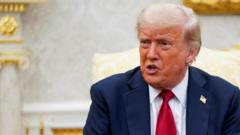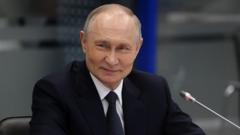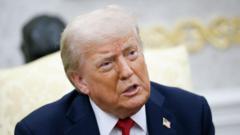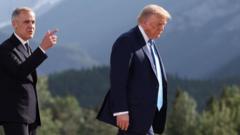China's economic growth rate has recently dipped to 5.2% for the second quarter, attributed to ongoing trade tensions with the U.S. and a severe slump in the real estate sector. Despite these challenges, growth in manufacturing and services provided some positive momentum.
China's Economic Growth Declines Amid Trade Tensions and Property Market Crisis

China's Economic Growth Declines Amid Trade Tensions and Property Market Crisis
China's economy grapples with declining growth rates as trade disputes with the U.S. and a struggling property market impact the nation's financial landscape.
China's economy is facing headwinds as recent data reveals a slower growth rate of 5.2% in the second quarter of 2023, slightly lower than the 5.4% achieved in the previous quarter. This decline is fueled by ongoing trade turmoil caused by U.S. tariffs introduced during President Donald Trump’s administration alongside a prolonged crisis in the real estate market.
The National Bureau of Statistics acknowledged that despite these pressures, the economy has shown signs of resilience, particularly supported by government measures and a tentative ceasefire in tariff conflicts between the U.S. and China. Manufacturing saw an impressive 6.4% bump, driven by rising demand for technologies like 3D printing and electric vehicles. However, the services sector also registered growth, although retail sales suffered a setback, slowing to a 4.8% increase compared to 6.4% in the previous month.
Moreover, a stark 8-month low was recorded in new home prices in June, indicating that the property sector remains in a state of distress despite various stimulus efforts aimed at stabilizing home values. Economists are now speculating that China may fall short of its annual growth target of around 5%.
Dan Wang from Eurasia Group notes that while a downturn seems inevitable, it will likely not plunge below 4%, which he describes as the politically acceptable threshold. Factors contributing to China's economic woes include significant tariffs: the U.S. has implemented a hefty 145% duty on certain Chinese imports, to which Beijing responded with a 125% tariff on select U.S. goods.
While recent negotiations in Geneva and London have led to a temporary pause in these tariffs, the two economic powerhouses are under pressure to finalize a long-term trade agreement by August 12. Additionally, tariffs imposed on nations closely tied to China's economy by the U.S. could compound the challenges ahead.
The National Bureau of Statistics acknowledged that despite these pressures, the economy has shown signs of resilience, particularly supported by government measures and a tentative ceasefire in tariff conflicts between the U.S. and China. Manufacturing saw an impressive 6.4% bump, driven by rising demand for technologies like 3D printing and electric vehicles. However, the services sector also registered growth, although retail sales suffered a setback, slowing to a 4.8% increase compared to 6.4% in the previous month.
Moreover, a stark 8-month low was recorded in new home prices in June, indicating that the property sector remains in a state of distress despite various stimulus efforts aimed at stabilizing home values. Economists are now speculating that China may fall short of its annual growth target of around 5%.
Dan Wang from Eurasia Group notes that while a downturn seems inevitable, it will likely not plunge below 4%, which he describes as the politically acceptable threshold. Factors contributing to China's economic woes include significant tariffs: the U.S. has implemented a hefty 145% duty on certain Chinese imports, to which Beijing responded with a 125% tariff on select U.S. goods.
While recent negotiations in Geneva and London have led to a temporary pause in these tariffs, the two economic powerhouses are under pressure to finalize a long-term trade agreement by August 12. Additionally, tariffs imposed on nations closely tied to China's economy by the U.S. could compound the challenges ahead.



















